YOUR CART
- No products in the cart.
Subtotal:
$0.00

Every seashell tells a story, and Bethany Duffy aims to tell those stories with needle and thread. Her miniature textile art shares the energy and motion of the vast seas from which her collection of shells emerged. And it’s all quite remarkable!
At first, Bethany stitched in secrecy. She knew she wanted to incorporate her beloved shell collection into her embroidery, but she wasn’t sure how to make that happen. So, she hid her first attempts, not wanting others to judge. Eventually, she shared her work with close family and friends, and the overwhelming praise encouraged her to keep going.
Bethany has developed a novel way to not only attach seashells to fabric but to also stitch into free-standing shells. Holding one of her tiny creations in the palm of your hand is like holding a bit of the ocean. The movement and energy she creates with simple stitches is incredible, and she’s now sharing her artistic process and journey with you.
Bethany also offers advice about collecting seashells for your own work. Knowing her washed up beach treasures are gifts from nature, she explains why it’s important to handle and collect seashells properly.
Enjoy this textile trek to the seaside.
Bethany Duffy: It’s important to be yourself and unique in your work. Believe in your ideas and have confidence in your ability.
Not every idea and piece of work has to be a masterpiece. Finding your style is tricky, but it’s yours to find.
Growing up, I wasn’t surrounded by textile or other art forms. My auntie and mum made our World Book Day costumes every year, but that is the only memory I have of someone working creatively with fabric.
I also remember watching my nana knit, but it was something I never really tried. I was always playing with paint, pencils and paper instead.
It wasn’t until I was nearly an adult that I became aware of textiles and developed a passion for working with them. My journey began when I was 16 and started studying A-Level textiles in college. I had always thought my artistic journey would go down the fine art route. But when I had the opportunity to work with fabric and other textiles, I realised that wouldn’t be the case. I also discovered embroidery during that two-year programme.
I went on to pursue a degree in hand embroidery at the Royal School of Needlework. We explored a variety of techniques in depth, and their standards required intense and detailed work. I learned techniques such as silk shading, gold work, raised work, whitework and many techniques I didn’t even know about.
I’m grateful to have moved forward after graduating with a strong and knowledgeable foundation that helped me discover who I am as an artist. But it’s also important to focus on developing your own skills. Just because everyone else does something, that doesn’t mean you must follow. There are no rules, and it’s important not to compare yourself to others.
The inspiration for my seascapes came from a visit to my Nana’s hometown in North Wales. Although I had visited there most every year as a child, I hadn’t been back to visit for about eight years. I wanted to share the trip with my partner, and it was meant to be for personal reasons, not artistic or work-related purposes.
While there, I started collecting shells. Without realising it, I suddenly had a handful! They sparked my curiosity and that childish sense of wonder.
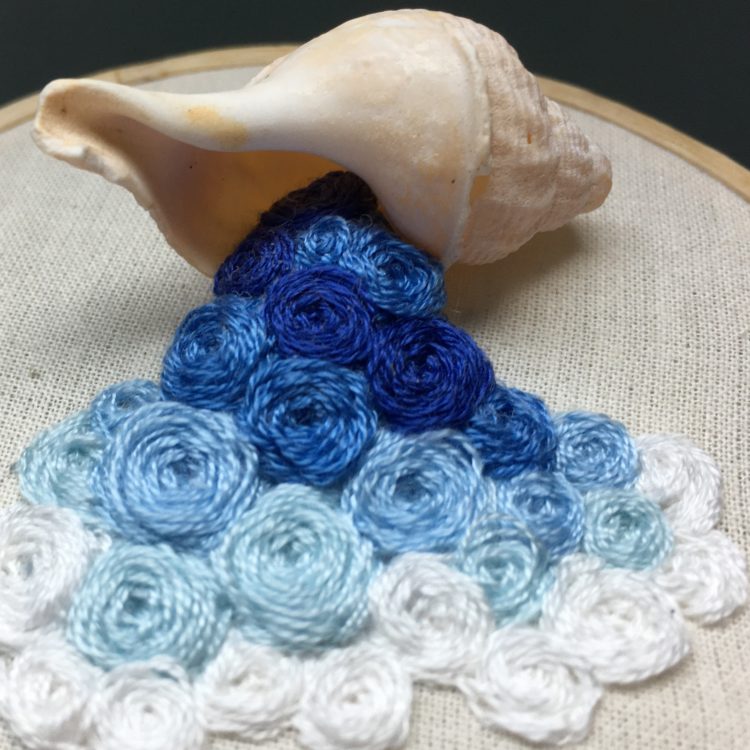
It wasn’t until weeks later I found myself staring at the shells around one in the morning and wondering how I could use them with embroidery. I had some ideas but I didn’t know if they would work. So, I just started stitching.
I stayed up until I finished a piece, and I was thrilled with how it turned out. It was authentic and natural. There was no pressure to create it, and I realised embroidery was something I had missed and forgotten a bit how to do.
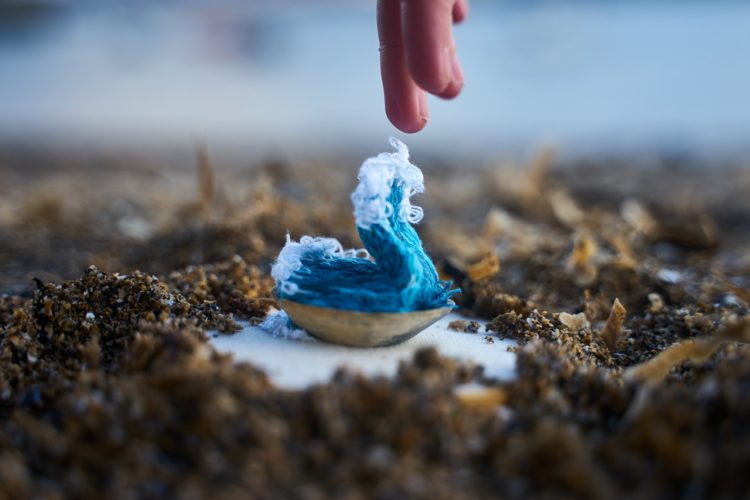
But I didn’t share the piece for months, as I had grown so attached to it and the general idea of stitching with shells. I think I just wanted it all for myself and didn’t want my work to be judged.
Then when I did ultimately share the work, I was blown away by the positive reactions I received. That’s when I started to expand my process and develop my own techniques with other pieces.
Being creative and being able to form ideas is a privilege and not something everyone can do. So, trust your instincts and have fun.
Many of my pieces are not pre-planned. I just work and create as I go. I start with the shell and then work from that. I look at its colour, form and how it sits on the fabric.
I work from memory and figure out how a wave and water might move around the shape. Getting it to look organic and natural on the fabric is difficult when creating something 3D. It can be difficult to work threads and stitches the way I want them to appear.
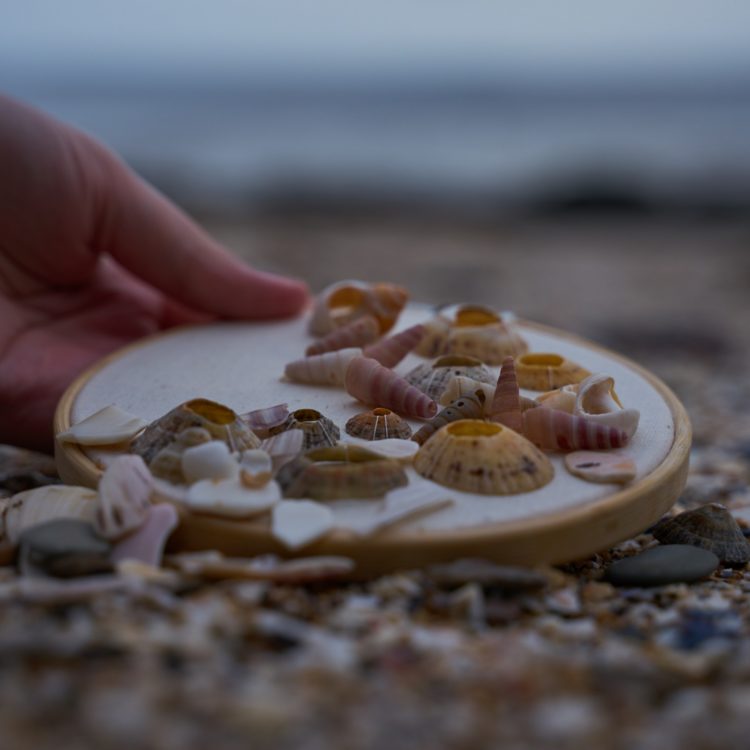
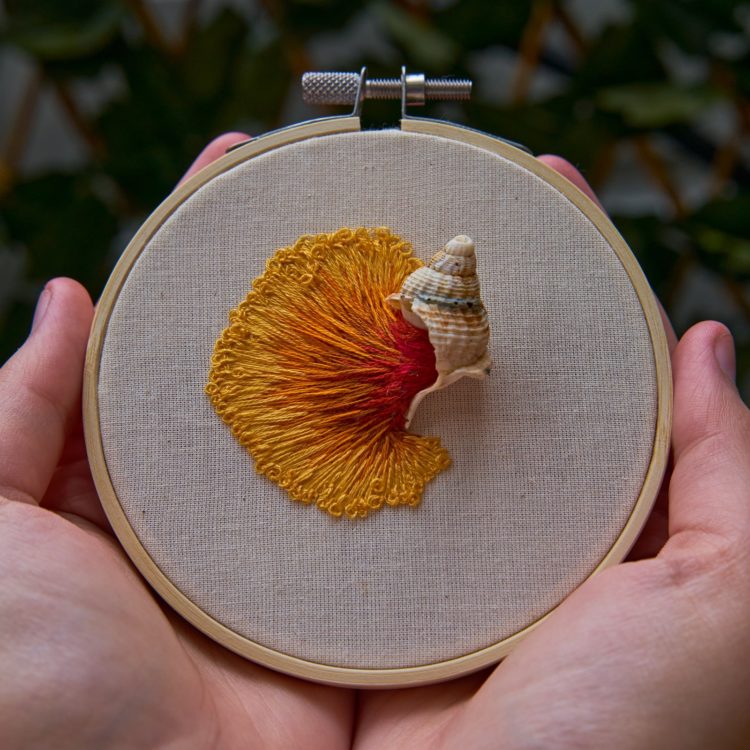
I’m still learning and constantly evolving, and my creative practice is always developing.
I do want to start carrying a sketchbook, though. That’s something I’m out of practice with that I want to revisit. I had stopped using them during university, but I think at this point in my practice, sketchbooks could be really helpful. I don’t think I’ll be mapping out specific pieces with loads of detail, but I do think recording water and movement will be my starting point.
I first start with the shell itself. I now have a whole collection of shells of different types, colours and from a whole host of places.
I must first say that before I start collecting shells, I make sure I’m allowed to do so. Beaches across the world are often signposted about collecting shells. And if you don’t see signs, a quick check on a council or local website will tell us. I don’t want to harm the landscape, so I only take small amounts. I also make sure to only take broken shells, as they can’t be used by animals and nature anymore.
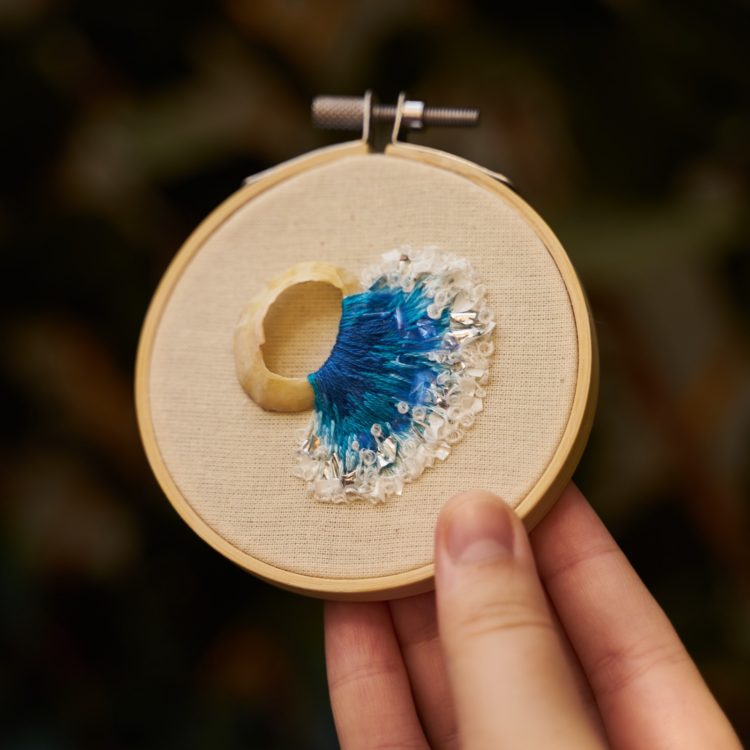
After choosing a shell, I start to think about its possibilities. I try different placements to see how it will sit or roll on a fabric’s surface. Once I like how it sits, I stitch it down.
Once a shell is attached, I then look more closely at its form and how I want the water to come out of the shell. To map out my waves, I use a fabric padding that’s attached to the base fabric, and then I stitch directly on top of the padding.
Regardless of how many strands of cotton or other thread I use, I end up adding a lot of stitchwork to cover up the padding. But the more stitches I have, the more movement I can add to a piece. The numerous threads help add texture and depth to a piece.
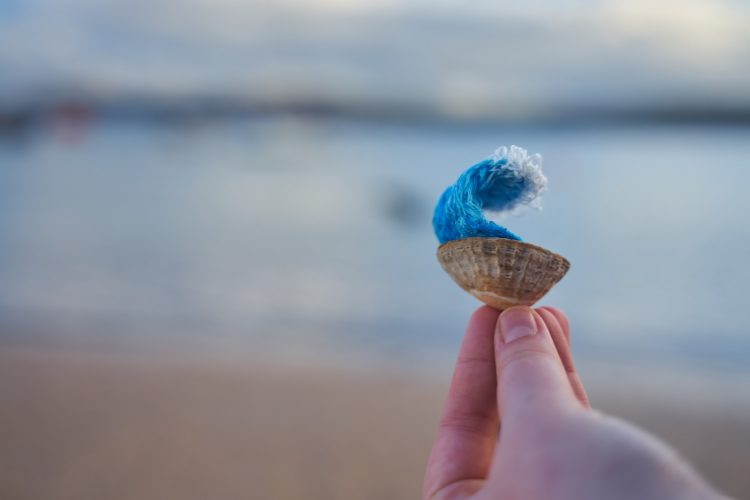
I then choose a colour palette based on photos I took, personal memories or the colours of the actual shell. I delve into my stash and choose four or more colours, depending on the size of the work.
I then start stitching, thinking of the form I want to create and the smoothness of the water. And if I want to add anything else like beads or other shells, I’ll work colour by colour to make sure everything blends throughout the piece.
My favourite stitches are ‘long and short stitches’, along with French knots. Long and short stitches are so versatile, and they help me create all the movement within a piece. I’m also able to move around corners and add curves by varying the length of my stitches.
French knots add the seafoam effect. It’s such a fun stitch, especially when you play with the tension of the stitch. French knots not only create height but they can also be used in clusters or individually scattered throughout the piece.
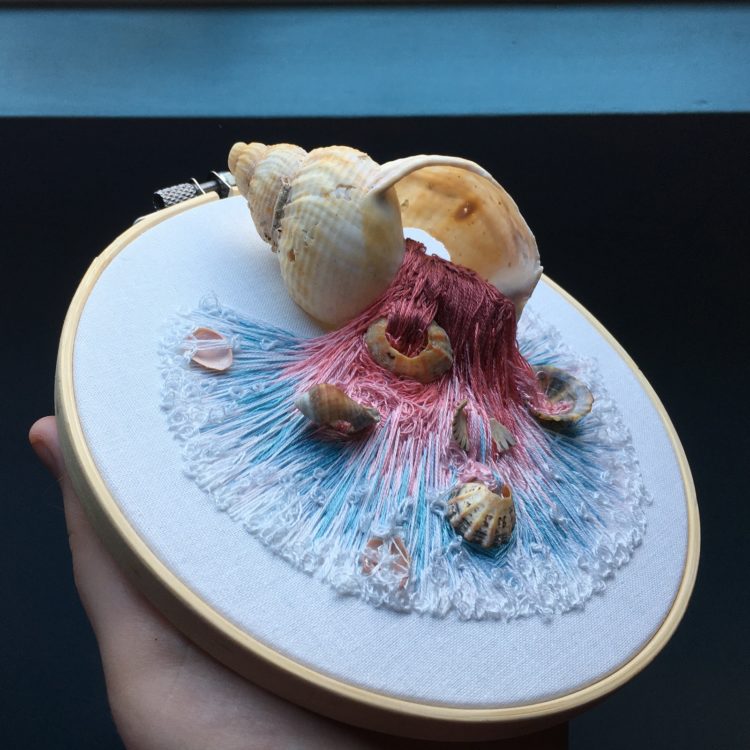
When creating pieces that aren’t attached to fabric or mounted in a hoop, I stitch onto fabric and then piece things together. I either stitch fabric freehand or on fabric in a hoop that I later remove and cut out.
I then place my stitched bits into the shell, giving it a little push into a fold or hole of the shell. I find they usually hold up well. I don’t need to use glue, and I avoid it if I can. I find the glue leaves a residue, and I don’t want to ruin the work during the last stage. Not using glue also allows me to build upon or change a piece in the future.
Stumpwork, also known as ‘raised work’, is a form of hand embroidery that is highly decorative and in which a design is raised from the surface. It’s a perfect technique for storytelling, and it’s often used in pieces depicting scenes with florals and figures. Wires, padding, ribbons and stitches like picots and needle lace create height and form that stands away from the fabric.
I learnt this technique in my second year of university and fell in love with it. I struggled learning other techniques like goldwork but for some reason, raised work just clicked with me. My new materials definitely posed a challenge, but I enjoyed having to problem solve and plan how every stitch would help form a shape. It’s ironic to me how a technique I initially knew very little about has now become my main technique.
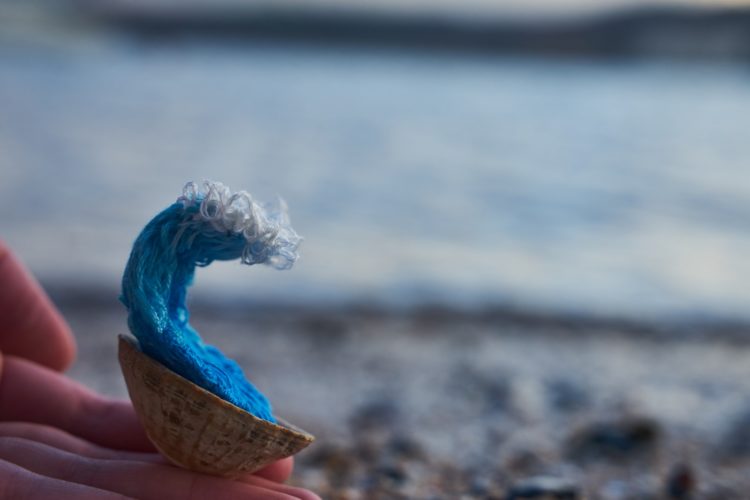
The material I use in most of my work is cotton calico. I like it because it’s nice to work with, is easily accessible and is sold in different weights.
My hometown in the Peak District of Derbyshire where I still live today is a mill town in the north of England. It was once one of the biggest producers of printed calico. I didn’t realise that until I was well into my embroidery journey, and I find that fact to be both inspiring and an amazing coincidence.
I typically use stranded cotton, as it’s easily accessible and has a nice feel. I use the DMC brand, because it’s strong and offers a huge range of colours. I’ll typically use one to three strands, but I mostly use two as they offer good coverage that’s still easy to stitch through.
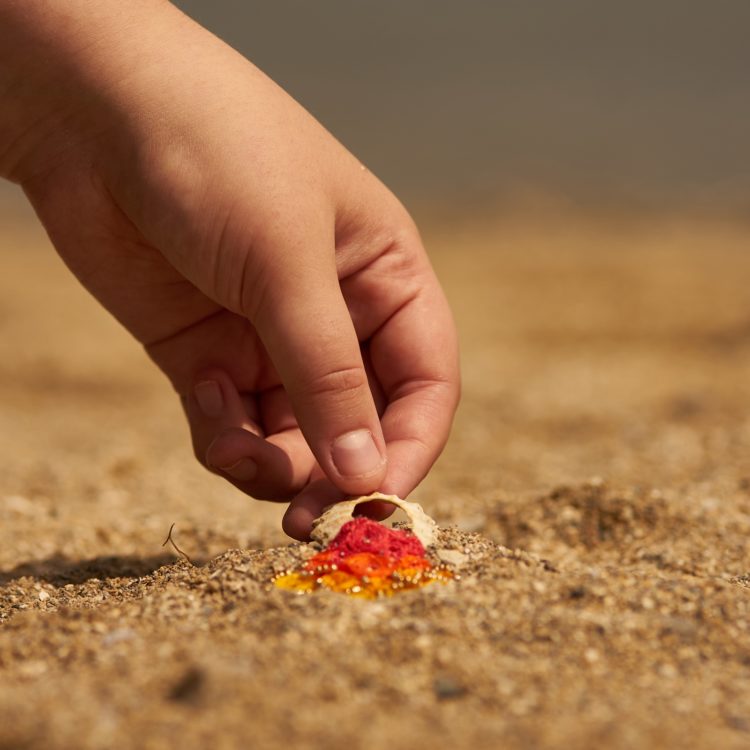
I also like to introduce a few different materials into my work. I have used thin plastics, such as scrap plastics or bags, that are easy to couch onto my fabrics to create a crashing water effect. But I remain tentative about using beads, as I find them hard to make look realistic.I also hope to use more found natural objects in future work.
The one tool I couldn’t live without is my embroidery scissors. I use gold Whiteley embroidery scissors, and I love their precision and help in keeping my work tidy as I stitch. The scissors’ weight, size and point are perfection.
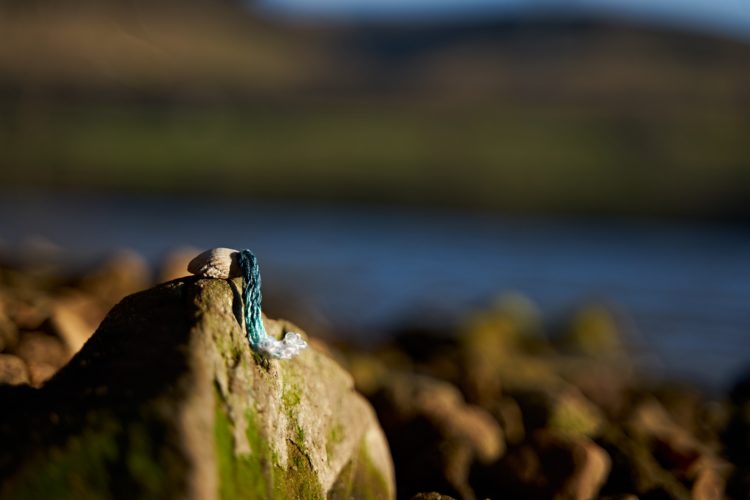
Bethany Duffy is based in Derbyshire. She runs an embroidery business from home, for which she recently won a Theo Paphitis Small Business Sunday award. Her work has been exhibited across the UK, as well as Portugal and Australia. She also teaches hand embroidery and is working on creating new learning materials.
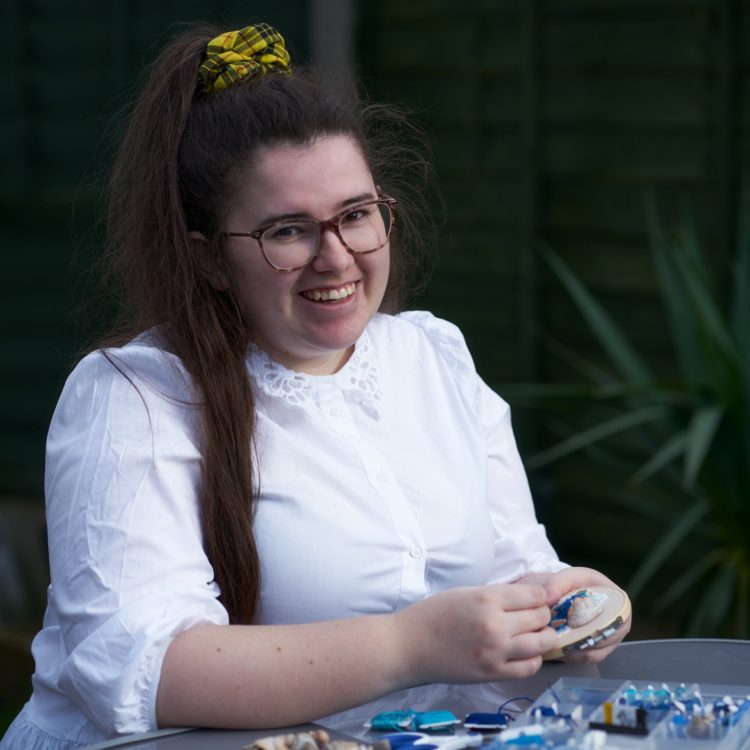
Website: www.bethanyduffyembroidery.com
Facebook: facebook.com/bethanyduffyembroidery
Instagram: @bethany_duffy_embroidery
If you enjoyed learning how Bethany stitches with shells from her collection, check out artist Jette Clover who embeds her stamp collection into her textile art.